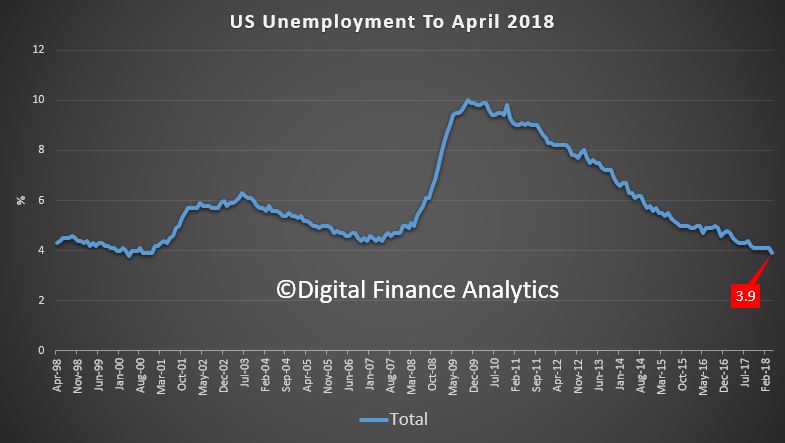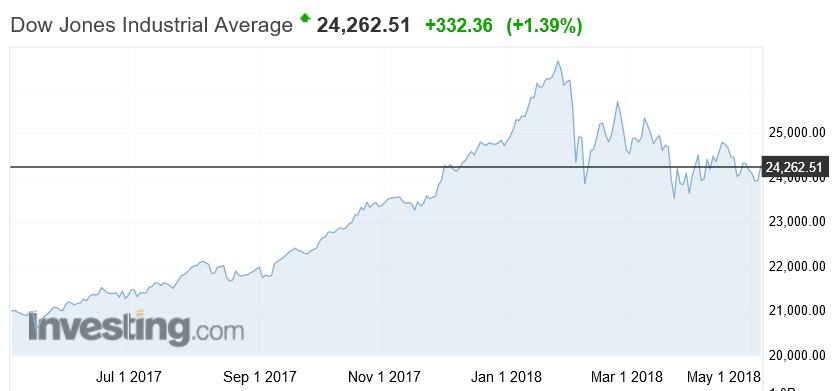Total nonfarm payroll employment increased by 164,000 in April, and the unemployment rate edged down to 3.9 percent, the U.S. Bureau of Labor Statistics reported. This is the lowest number since 2000! Job gains occurred in professional and business services, manufacturing, health care, and mining.
 The market reacted positively, with the lower number sitting in the “Goldilocks” zone meaning the FED’s programme of rate rises can continue as planned. Wages growth remains constrained, so inflation is controlled.
The market reacted positively, with the lower number sitting in the “Goldilocks” zone meaning the FED’s programme of rate rises can continue as planned. Wages growth remains constrained, so inflation is controlled.
Household Survey Data
In April, the unemployment rate edged down to 3.9 percent, following 6 months at 4.1 percent. The number of unemployed persons, at 6.3 million, also edged down over the month. Among the major worker groups, the unemployment rate for adult women decreased to 3.5 percent in April. The jobless rates for adult men (3.7 percent), teenagers (12.9 percent), Whites (3.6 percent), Blacks (6.6 percent), Asians (2.8 percent), and Hispanics (4.8 percent) showed little or no change over the month.
Among the unemployed, the number of job losers and persons who completed temporary jobs declined by 188,000 in April to 3.0 million.
The number of long-term unemployed (those jobless for 27 weeks or more) was little changed at 1.3 million in April and accounted for 20.0 percent of the unemployed. Over the year, the number of long-term unemployed was down by 340,000.
Both the labor force participation rate, at 62.8 percent, and the employment-population ratio, at 60.3 percent, changed little in April.
The number of persons employed part time for economic reasons (sometimes referred to as involuntary part-time workers) was essentially unchanged at 5.0 million in April. These individuals, who would have preferred full-time employment, were working part time because their hours had been reduced or because they were unable
to find full-time jobs.In April, 1.4 million persons were marginally attached to the labor force, down by 172,000 from a year earlier. (The data are not seasonally adjusted.) These individuals were not in the labor force, wanted and were available for work, and had looked for a job sometime in the prior 12 months. They were not counted as unemployed because they had not searched for work in the 4 weeks preceding the survey.
Among the marginally attached, there were 408,000 discouraged workers in April, little changed from a year earlier. (The data are not seasonally adjusted.) Discouraged workers are persons not currently looking for work because they believe no jobs are available for them. The remaining 1.0 million persons marginally attached to the labor force in April had not searched for work for reasons such as school attendance or family responsibilities.
Establishment Survey Data
Total nonfarm payroll employment increased by 164,000 in April, compared with an average monthly gain of 191,000 over the prior 12 months. In April, job gains occurred in professional and business services, manufacturing, health care, and mining.
In April, employment in professional and business services increased by 54,000. Over the past 12 months, the industry has added 518,000 jobs.
Employment in manufacturing increased by 24,000 in April. Most of the gain was in the durable goods component, with machinery adding 8,000 jobs and employment in fabricated metal products continuing to trend up (+4,000). Manufacturing employment has risen by 245,000 over the year, with about three-fourths of the growth in durable goods industries.
Health care added 24,000 jobs in April and 305,000 jobs over the year. In April, employment rose in ambulatory health care services (+17,000) and hospitals (+8,000).
In April, employment in mining increased by 8,000, with most of the gain occurring in support activities for mining (+7,000). Since a recent low in October 2016, employment in mining has risen by 86,000.
Employment changed little over the month in other major industries, including construction, wholesale trade, retail trade, transportation and warehousing, information, financial activities, leisure and hospitality, and government.
The average workweek for all employees on private nonfarm payrolls was unchanged at 34.5 hours in April. In manufacturing, the workweek increased by 0.2 hour to 41.1 hours, while overtime edged up by 0.1 hour to 3.7 hours. The average workweek for production and nonsupervisory employees on private nonfarm payrolls increased by 0.1 hour to 33.8 hours.
In April, average hourly earnings for all employees on private nonfarm payrolls rose by 4 cents to $26.84. Over the year, average hourly earnings have increased by 67 cents, or 2.6 percent. Average hourly earnings of private-sector production and nonsupervisory employees increased by 5 cents to $22.51 in April.
The change in total nonfarm payroll employment for February was revised down from +326,000 to +324,000, and the change for March was revised up from +103,000 to +135,000. With these revisions, employment gains in February and March combined were 30,000 more than previously reported. (Monthly revisions result from additional reports received from businesses and government agencies since the last published estimates and from the recalculation of seasonal factors.) After revisions, job gains have averaged 208,000 over the last 3 months.

